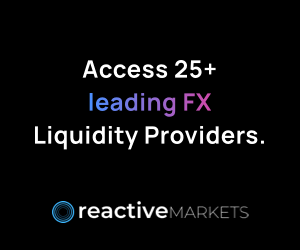The Last Look…
Well, I was going to write about FX platforms, but for a different reason…these things happen so let’s get into it, what has the reaction been in the first few days since news of the lawsuit against Currenex, HC Tech, Goldman Sachs, State Street and others broke?
My first take is available here, but with the benefit of a weekend to go through the extensive feedback and reaction to the story, there are a few things to go into a little deeper.
The reaction has come in three distinct forms – those who are quick to pronounce the defendants guilty; those who are genuinely shocked by the accusations; and those who feel I was too harsh on anonymous trading as a whole in my first take. As to the first of those groups, as I mentioned on Friday, this has been a staple of the platform industry for the best part of two decades. I cannot count the number of times when someone at one platform has pointed to another and said something that starts with, “You know what they’re up to…?”
On one hand there is no smoke without fire, on the other, innocent until proven guilty. This is not the first time the FX industry has faced this kind of trouble, as was pointed out to me by several respondents.
On the third reaction above, two or three of you took me to task for suggesting there was a problem with anonymous trading in general. I don’t think I did, but nevertheless I need to stress I am not suggesting anyone is playing games in this world – in fact I would reiterate that the accusations that kicked off a frenzied period of activity across my messaging channels are still unproven – but we need to face facts, which brings me to the second reaction noted above.
End users of platforms were genuinely shocked at the revelations and several told me their “eyes have been opened” reading our report on the lawsuit. The natural reaction was, “how do we know that what we are being told by anyone is true?”
Now in fairness I don’t think we can go through life with that level of paranoia (and equally fairly, my correspondents were taking what they accepted was an extreme view), but the fact is – as the chat room saga showed – a whole industry can easily be judged by the alleged actions of one or two.
This is why I observed on Friday that while the GFXC work on anonymous trading has provided a lot of clarity (which is yet to be fully executed I would also observe), it is now time for the industry itself to step up and take responsibility. I have spent literally years calling for the platform providers to take more control over behaviours on their trading venues and (notwithstanding these accusations are about something imposed by the platform), we still fall well short of what I, and many of my correspondents, consider to be acceptable transparency.
Very few platforms go to the level of detail on volumes that many see as necessary, how much is spot or forward, how much on what venue? Equally, how many platforms break out and publish hit ratios?
If I look at what I can find out, as an informed observer of this business, when looking at the platform providers’ output, hopefully it explains what I think should be done.
On volumes, a great number of venues publish data, some daily, some monthly, some annually and, inevitably, some not at all. Very few, however, actually go to the level of detail that I would deem appropriate, especially if I were a market participant seeking to connect. Some venues bulk in all FX products together – the majority of ADV may be spot but not all – comparing apples with apples is very difficult in this space.
Equally, some venues break out spot from other products, but don’t break down exactly how much is going through the many liquidity pools they operate. It is more complex for those firms operating multiple venues, but they are often bigger organisations anyway, with the resources.
There is also behaviour. How many platforms break out and publish hit ratios for example? As far as I can tell it is one – CboeFX. I have written recently about last look, specifically the analysis of one firm’s round trip times on a major platform during which I argued that customers need to take some responsibility and look at their rate of, and cost of, rejects. To be fair to them, we need to ask how many platforms actually provide that data? Many do, but the very fact there are still some who don’t highlights the challenge – as the banks found out in the wake of the chat room scandal, it’s not enough to say you’re clean, you have to prove it.
I actually think the platform industry can learn from the banks’ response to the chat room fiasco. They built and imposed surveillance regimes around their trading businesses which were operated by a different unit within the organisation. They don’t publish the results, but certain authorities can access them, which gives everyone a degree of comfort. More importantly, with everything now checked and saved, potential miscreants know there is a real chance that their activities will not only be discovered, but proven easily.
This is where the platforms need to go now if they are to maintain, or restore, trust in the anonymous trading environment. If the users of these platforms – and the latest allegations are a potential hit to liquidity providers as well as consumers – have anything about them, they will be asking harsher, more pointed, questions and the platforms better be ready. As I noted in this column in April, it’s not always the easiest thing to find a rulebook on venues’ websites, but access to a rulebook will be the first, and easiest, question to answer – the others less so.
I happen to think that the vast majority of people in the platforms, as is the case in the FX industry, do the right thing. The problem, as the chat room scandal highlighted, is that they are judged by the lowest common denominator – any time a major player in the industry is accused of something, it radiates out. Is it fair? Probably not. Is it reality? Sadly yes.
If trust is undermined in an industry, it’s tough to get back – why do you think peer-to-peer venues are suddenly getting a look in after the chat room scandal? – so the time to act is now.
This month will see the release of the GFXC template for e-trading platform disclosures, which is a step in the right direction, so perhaps the solution for those platform providers confident in their operating procedures is to make these disclosures publicly available? At the very least, any client who thought they were not getting the same level of information as disclosed would be able to raise the issue and the platform could rectify any issues early.
To back that up, more detailed information around hit ratios, average quote lifespan, cancellations and more could be made available for the customer, alongside the platform’s average across its entire client base.
This probably all sounds tiresome to anyone in the platform game, but going forward, the level of detail available to current and prospective customers could be a differentiator. If trust is undermined in an industry, it’s tough to get back – why do you think peer-to-peer venues are suddenly getting a look in after the chat room scandal? – so the time to act is now.
It may seem an unnecessary nuisance, but as any senior FX banker will tell you, it’s not only about being whiter than white – it’s proving it. Higher scrutiny of the platforms is inevitable, those that are ready to meet the challenge and (ideally independently) ratify their procedures are adhered to, could well be the winners.
Conduct should not be a differentiator, everyone should be at the same (high) level, but in the near future proving it may well be.
@colinlambertFX





